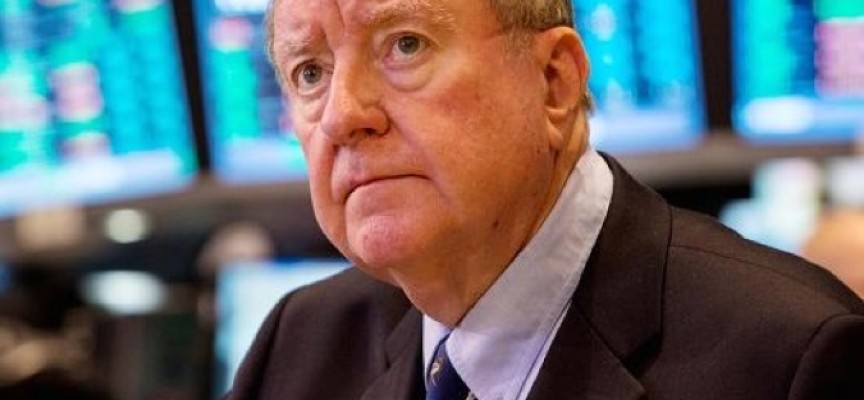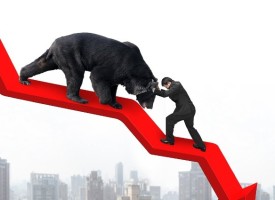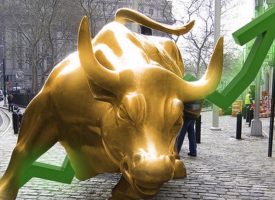After yesterday’s plunge in stocks and today’s early rally, here is the big danger.
Tokyo Plunges Equivalent Of Over 900 Points In The Dow
October 25 (King World News) – Here is a portion of today’s note from legend Art Cashin: Traders were doing a lot of digging on Wednesday but it had nothing to do with canals.
The Dow opened slightly better, primarily on a boost from Boeing, which rallied on a solid earnings report. The other indices opened lower and continued to weaken and eventually pulled the Dow into negative territory.
What followed was a series of level tests. A key event came right around the European close. The S&P tested the 2700 level at the same time the Dow was testing 24,900.
The indices held above those levels and that brought in buyers who helped lift the indices smartly.
While the rally was relatively sharp, it had a very short shelf-life and ended suddenly after about 20 minutes.
Stocks then traded choppily lower over the next two hours until they began to retest their late morning lows. At first, it looked like the lows might hold and that brought in a spate of bargain hunters.
Unfortunately, the rally never really caught on and stocks rolled over. When they violated the earlier lows, algorithmic selling seemed to kick in and stocks took a nosedive in accelerating volume.
The techs took it on the chin again, sending the Nasdaq down a whopping 4.43%, which is the equivalent of over a thousand points in the Dow. Not quite capitulation but rather ugly nevertheless.
Is The Fed Misreading The Economy? – For months we have been postulating that the Fed may be too aggressive in their tightening posture. We have maintained that the Fed may be misreading the “new economy”.
In Wednesday’s Financial Times, we found a letter that eloquently lays out a very similar thesis. It was penned by Stefan Abrams by Bryan-Abrams Investment Management. We thought it valuable enough to repeat the entire letter. Here it is:
Fed policy looks set to hasten the arrival of the next downturn From Stefan D Abrams, New York, NY, US / October 23, 2018
Unfortunately, the FOMC’s focus on the currently low (3.7 per cent) rate of unemployment has left it oblivious to a number of forces that are not only suppressing inflation, but in addition are slowing the economy’s growth rate.
First of all, there is no such thing as wage push inflation. That is a totally fallacious concept. Inflation is always a monetary phenomenon, ie too much money chasing too few goods and services. Over the past year, broad money
supply (M2) has expanded at a 3.8 per cent pace, well under the growth rate of nominal gross domestic product at 5 per cent-plus.
Together with the gradual shrinking of the Fed’s balance sheet, the increases in the federal funds rate and tepid loan demand have all contributed to what is a mild liquidity squeeze, hardly a backdrop for accelerating inflation. Also, inflation is being restrained by various structural factors, including globalisation, technological advances, intense competition by various disrupters, demographic factors and a strong dollar, the latter in part a function of a rising federal funds rate.
Moreover, the economy is already slowing, for example housing and autos. The Trump tariffs are raising input costs in some industries, which will either be absorbed by companies, thereby inhibiting their growth, or offset by raising taxes on consumers, neither of which can be constrained by a tighter monetary policy. An array of data from both the industrialised and emerging economies indicates that a global slowdown is under way. Of particular importance to the US is the pronounced slowdown in China.
It would seem that today’s FOMC members believe they have learnt from the Fed’s historical mistakes, but they are failing to understand that “this time it really is different”. If the Fed continues on its current rate-rising path in a desire to build up the weaponry with which to combat the next cyclical downturn, it will only hasten the downturn’s arrival.
We think Mr. Abrams is spot on. The Fed would do well to read his letter.
One further thought on rates.
We’ve had several Treasury auctions in recent days. Ordinarily, with the stock market in freefall, Treasuries are a hot property, benefitting both from a flight to safety and a storehouse for the funds from stock sales.
The auctions this week have been rather poorly bid. That leads traders to suspect that maybe the Chinese are boycotting. Worth keeping an eye on.
Overnight And Overseas – Asia equity markets were a bit all over the lot. Tokyo plunged the equivalent of over 900 points in the Dow. Hong Kong fell only 200 Dow points. Shanghai, on the other hand, closed with a fractional gain, with some suspecting a boost from the government.
The Shanghai performance seems to have helped other markets regroup. Stocks in Europe are seeing mild to moderate gains. London is up fractionally but Frankfurt and Paris are showing solid gains.
Among other assets, Bitcoin is weaker, trading just above $6500. Gold is a touch firmer, while crude is basically flat. The euro is a shade higher against the dollar and yields are a tick or two higher.
Consensus – Europe rebounds as do U.S. stock futures. Without the full capitulation, Ye Olde Traders Handbook suggests a few days of level testing – primarily the recent lows.
Stay wary, alert and very, very nimble.
One Of The Greatest Interviews Of 2018
To listen to the man who worked side-by-side with the Chairman of the Comex in the 1970s and called the stock market crash of 1987 CLICK HERE OR ON THE IMAGE BELOW. What he had to say about what is coming for stocks, bonds and gold is priceless.
ALSO JUST RELEASED: Celente – The Worst Is Yet To Come For Stocks But Not For Gold CLICK HERE TO READ.
© 2018 by King World News®. All Rights Reserved. This material may not be published, broadcast, rewritten, or redistributed. However, linking directly to the articles is permitted and encouraged.








